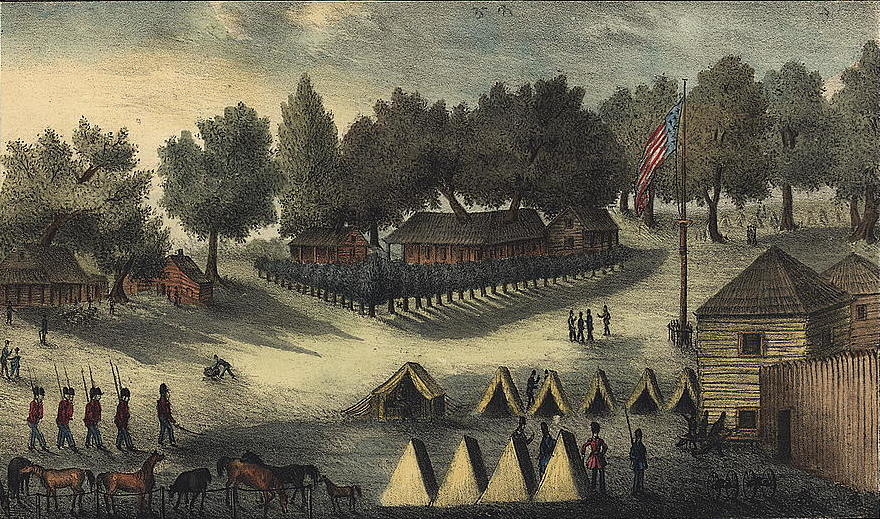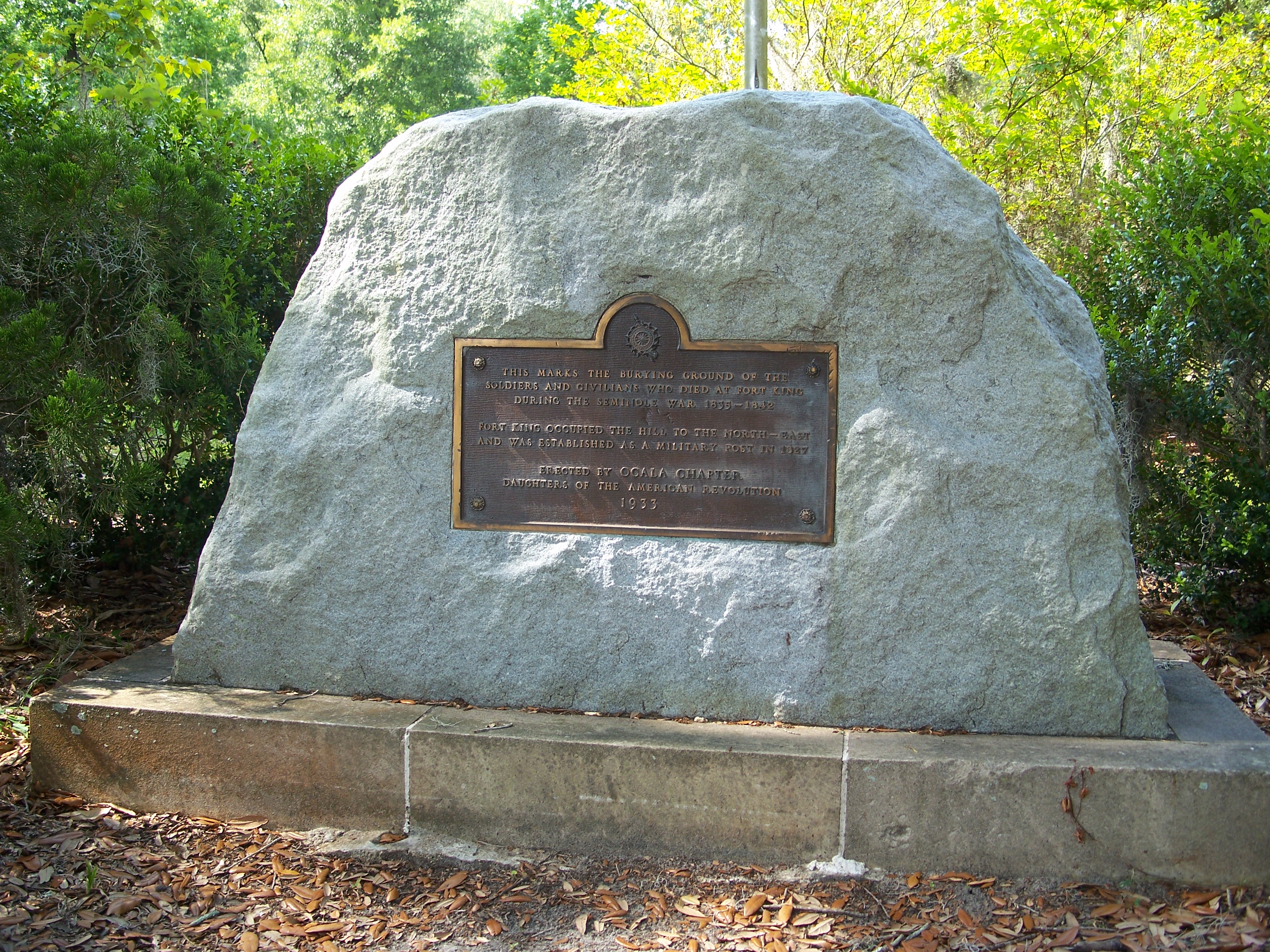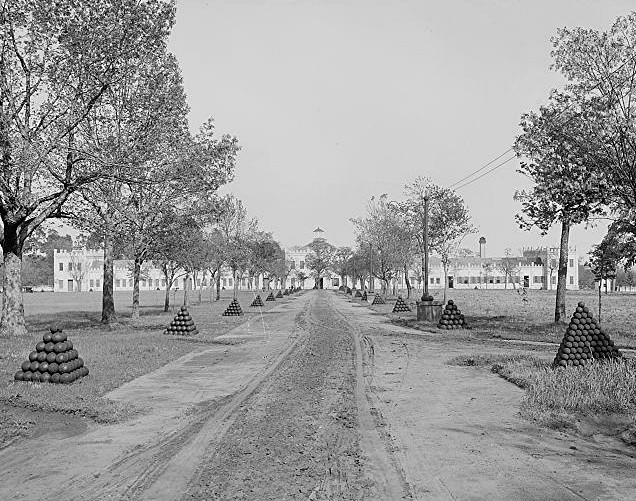|
Fort Basinger (Seminole War Fort)
Fort Basinger's original site is located approximately west of Fort Pierce, Florida along U. S. Highway 98 in Highlands County, Florida. It was a stockaded fortification with two blockhouses that was built in 1837 by the United States Army. It was one of the military outposts created during the Second Seminole War to assist Colonel Zachary Taylor's troops to confront and capture Seminole Indians and their allies in the central part of the Florida Territory in the Lake Okeechobee region. The Seminole Indians and their allies were resisting forced removal to federal territory west of the Mississippi River as directed by the Indian Removal Act.Roberts, Robert B. Encyclopedia of Historic Forts: The Military, Pioneer, and Trading Posts of the United States. New York: Macmillan. 1988, p. 169. Brief History On December 2, 1837, Colonel Zachary Taylor ordered the construction of Fort Gardiner during his Second Seminole War campaign as he marched his troops into the Lake Okeechobee reg ... [...More Info...] [...Related Items...] OR: [Wikipedia] [Google] [Baidu] |
Fort Pierce
Fort Pierce is a city in and the county seat of St. Lucie County, Florida, United States. The city is part of the Treasure Coast region of Atlantic Coast Florida. It is also known as the Sunrise City, sister to San Francisco, California, the Sunset City. Per the 2020 census, the population was 47,297. History It was named after the Fort Pierce Army post which was built nearby in 1838 during the Second Seminole War. The military post had been named for Benjamin Kendrick Pierce, a career United States Army officer and the brother of President Franklin Pierce. It was the largest city on Florida's Atlantic Coast between Daytona Beach and West Palm Beach until 1970 when it was surpassed by Melbourne. Geography According to the U. S. Census Bureau, the city has a total area of 20.8 mi2 (53.8 km2), of which 14.7 square miles (38.2 km2) is land and 6.0 square miles (15.6 km2) of it (35.00%) is water. Environment Shore Protection project According to the U. ... [...More Info...] [...Related Items...] OR: [Wikipedia] [Google] [Baidu] |
Fort Brooke
Fort Brooke was a historical military post established at the mouth of the Hillsborough River in present-day Tampa, Florida in 1824. Its original purpose was to serve as a check on and trading post for the native Seminoles who had been confined to an interior reservation by the Treaty of Moultrie Creek (1823), and it served as a military headquarters and port during the Second Seminole War (1835-1842). The village of Tampa developed just north of the fort during this period, and the area was the site of a minor raid and skirmish during the American Civil War. The obsolete outpost was sparsely garrisoned after the war, and it was decommissioned in 1883 just before Tampa began a period of rapid growth, opening the land for development. Fort Brooke was located on what is now the southern end of downtown Tampa along eastern bank of the river and the Garrison Channel. Most of the fort's structures were situated at the current site of the Tampa Convention Center, with the military r ... [...More Info...] [...Related Items...] OR: [Wikipedia] [Google] [Baidu] |
Fort King
Fort King (also known as Camp King or Cantonment King) was a United States military fort in north central Florida, near what later developed as the city of Ocala. It was named after Colonel William King, commander of Florida's Fourth Infantry and the first governor of the provisional West Florida region. The fort was built in 1827 during United States tensions with the Seminole in Florida, a tribe of mostly Creek people who formed in the early nineteenth century. Originally established to serve as a buffer between new settlers and the Seminole, the fort became an important base in the 1830s for the United States Army during removal of the Seminole and the Seminole Wars. It later served as a courthouse in 1844 after the organization of Marion County, but was eventually abandoned altogether. Residents took it apart to salvage building materials. The site of the fort is preserved as a National Historic Landmark near the corner of East Fort King Street and 39th Avenue in Ocala. In lat ... [...More Info...] [...Related Items...] OR: [Wikipedia] [Google] [Baidu] |
Francis L
Francis may refer to: People *Pope Francis, the head of the Catholic Church and sovereign of the Vatican City State and Bishop of Rome * Francis (given name), including a list of people and fictional characters * Francis (surname) Places *Rural Municipality of Francis No. 127, Saskatchewan, Canada *Francis, Saskatchewan, Canada ** Francis (electoral district) * Francis, Nebraska * Francis Township, Holt County, Nebraska *Francis, Oklahoma * Francis, Utah Other uses * ''Francis'' (film), the first of a series of comedies featuring Francis the Talking Mule, voiced by Chill Wills *''Francis'', a 1983 play by Julian Mitchell *FRANCIS, a bibliographic database * ''Francis'' (1793), a colonial schooner in Australia * Francis turbine, a type of water turbine * Francis (band), a Sweden-based folk band * Francis, a character played by YouTuber Boogie2988 See also *Saint Francis (other) St. Francis or Saint Francis may refer to: Roman Catholic saints *Francis of Assisi (1181� ... [...More Info...] [...Related Items...] OR: [Wikipedia] [Google] [Baidu] |
Fort Jackson, Louisiana
Fort Jackson is a historic masonry fort located up river from the mouth of the Mississippi River in Plaquemines Parish, Louisiana. It was constructed as a coastal defense of New Orleans, between 1822 and 1832, and it was a battle site during the American Civil War. It is a National Historic Landmark. It was damaged by Hurricanes Katrina and Rita, and its condition is threatened. It is marked Battery Millar on some maps, for the Endicott era work built nearby it. Fort Jackson is situated approximately south of New Orleans on the western bank of the Mississippi, approximately south of Triumph, Louisiana. The older Fort St. Philip is located opposite of Fort Jackson on the eastern bank; this West Bank fort was constructed after the War of 1812 on the advice of Andrew Jackson, for whom it is named. The fort was occupied off and on for various military purposes from its completion until after World War I, when it served as a training station. It is now a National Histori ... [...More Info...] [...Related Items...] OR: [Wikipedia] [Google] [Baidu] |
Augusta Arsenal
The Augusta Arsenal was a 19th-century fortification in Augusta, Georgia. Established in 1816 and initially completed on the Georgia bank of the Savannah River in 1819, it was moved to the former Belle Vue estate in the Summerville neighborhood of Augusta in 1827 due to health concerns after several fever epidemics. Early history The Belle Vue estate was established by George and Eliza Talbot Walker. It was the birthplace of their granddaughter, Octavia Walton Le Vert in 1811. George later sold Belle Vue to his brother, Freeman Walker, for use as a summer estate. Freeman Walker sold the property, with the exception of one acre that contained the Walker Family Cemetery, to the United States government for $6,000 in 1826. The arsenal was moved to the new location the following year, with four large brick buildings connected by a twenty-two inch thick wall completed in 1829. Troops from the arsenal took part in various campaigns involving the Cherokee, Muscogee, and Seminole t ... [...More Info...] [...Related Items...] OR: [Wikipedia] [Google] [Baidu] |
Fort Moultrie
Fort Moultrie is a series of fortifications on Sullivan's Island, South Carolina, built to protect the city of Charleston, South Carolina. The first fort, formerly named Fort Sullivan, built of palmetto logs, inspired the flag and nickname of South Carolina, as "The Palmetto State". The fort was renamed for the U.S. patriot commander in the Battle of Sullivan's Island, General William Moultrie. During British occupation, in 1780–1782, the fort was known as Fort Arbuthnot. History American Revolution Col. Moultrie took command of Sullivan's Island on March 2, 1776, which included a garrison of 413 men of the 2nd South Carolina Regiment of Infantry and 22 men of the 4th South Carolina Regiment, artillery. The island included a fort, still under construction at the southern tip, which was being supervised by Capt. De Brahm. The square design, with corner bastions, was supposed to have parallel rows of palmetto logs , filled in with . However, by June 28, only the ... [...More Info...] [...Related Items...] OR: [Wikipedia] [Google] [Baidu] |
Robert E
The name Robert is an ancient Germanic given name, from Proto-Germanic "fame" and "bright" (''Hrōþiberhtaz''). Compare Old Dutch ''Robrecht'' and Old High German ''Hrodebert'' (a compound of '' Hruod'' ( non, Hróðr) "fame, glory, honour, praise, renown" and '' berht'' "bright, light, shining"). It is the second most frequently used given name of ancient Germanic origin. It is also in use as a surname. Another commonly used form of the name is Rupert. After becoming widely used in Continental Europe it entered England in its Old French form ''Robert'', where an Old English cognate form (''Hrēodbēorht'', ''Hrodberht'', ''Hrēodbēorð'', ''Hrœdbœrð'', ''Hrœdberð'', ''Hrōðberχtŕ'') had existed before the Norman Conquest. The feminine version is Roberta. The Italian, Portuguese, and Spanish form is Roberto. Robert is also a common name in many Germanic languages, including English, German, Dutch, Norwegian, Swedish, Scots, Danish, and Icelandic. It c ... [...More Info...] [...Related Items...] OR: [Wikipedia] [Google] [Baidu] |
Joseph E
Joseph is a common male given name, derived from the Hebrew Yosef (יוֹסֵף). "Joseph" is used, along with "Josef", mostly in English, French and partially German languages. This spelling is also found as a variant in the languages of the modern-day Nordic countries. In Portuguese and Spanish, the name is "José". In Arabic, including in the Quran, the name is spelled '' Yūsuf''. In Persian, the name is "Yousef". The name has enjoyed significant popularity in its many forms in numerous countries, and ''Joseph'' was one of the two names, along with ''Robert'', to have remained in the top 10 boys' names list in the US from 1925 to 1972. It is especially common in contemporary Israel, as either "Yossi" or "Yossef", and in Italy, where the name "Giuseppe" was the most common male name in the 20th century. In the first century CE, Joseph was the second most popular male name for Palestine Jews. In the Book of Genesis Joseph is Jacob's eleventh son and Rachel's first son, and k ... [...More Info...] [...Related Items...] OR: [Wikipedia] [Google] [Baidu] |
West Point, New York
West Point is the oldest continuously occupied military post in the United States. Located on the Hudson River in New York (state), New York, West Point was identified by General George Washington as the most important strategic position in America during the American Revolution. Until January 1778, West Point was not occupied by the military. On January 27, 1778, Brigadier General Samuel Holden Parsons and his brigade crossed the ice on the Hudson River and climbed to the plain on West Point and from that day to the present, West Point has been occupied by the United States Army. It comprises approximately including the campus of the United States Military Academy, which is commonly called "West Point". West Point is a census-designated place (CDP) located in the town of Highlands, New York, Highlands in Orange County, New York, Orange County, located on the western bank of the Hudson River. The population was 6,763 at the 2010 census. It is part of the New York–Newark–Jerse ... [...More Info...] [...Related Items...] OR: [Wikipedia] [Google] [Baidu] |
United States Military Academy
The United States Military Academy (USMA), also known Metonymy, metonymically as West Point or simply as Army, is a United States service academies, United States service academy in West Point, New York. It was originally established as a fort, since it sits on strategic high ground overlooking the Hudson River with a scenic view, north of New York City. It is the oldest of the five American service academies and educates cadets for Commission (document)#United States, commissioning into the United States Army. The academy was founded in 1802, one year after President Thomas Jefferson directed that plans be set in motion to establish it. It was constructed on site of Fort Clinton (West Point), Fort Clinton on West Point overlooking the Hudson, which Colonial General Benedict Arnold conspired to turn over to the British during the American Revolutionary War, Revolutionary War. The entire central campus is a National Historic Landmark, national landmark and home to scores of ... [...More Info...] [...Related Items...] OR: [Wikipedia] [Google] [Baidu] |
Thirteen Colonies
The Thirteen Colonies, also known as the Thirteen British Colonies, the Thirteen American Colonies, or later as the United Colonies, were a group of British colonies on the Atlantic coast of North America. Founded in the 17th and 18th centuries, they began fighting the American Revolutionary War in April 1775 and formed the United States of America by declaring full independence in July 1776. Just prior to declaring independence, the Thirteen Colonies in their traditional groupings were: New England (New Hampshire; Massachusetts; Rhode Island; Connecticut); Middle (New York; New Jersey; Pennsylvania; Delaware); Southern (Maryland; Virginia; North Carolina; South Carolina; and Georgia). The Thirteen Colonies came to have very similar political, constitutional, and legal systems, dominated by Protestant English-speakers. The first of these colonies was Virginia Colony in 1607, a Southern colony. While all these colonies needed to become economically viable, the founding of ... [...More Info...] [...Related Items...] OR: [Wikipedia] [Google] [Baidu] |





_crop.jpg)
.jpg)
